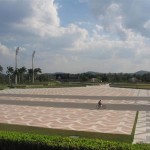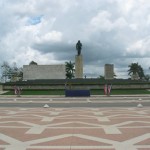The Integration of Public Space, Dividing Private Lives
May 2, 2012 by admin
What is public space? How does it differ from a tourist attraction? Is there a difference between spaces that happens to be public and spaces made to be public? Town squares and parks stretch across the United States as places for people – both locals and visitors – to congregate, socialize, and relax. But these spaces have no political meaning or message. A square in front of City Hall may conveniently provide a space for protest, but here the monument created the event. In Cuba, the event created the monument, the revolution built Revolution Square, and Che Guevara’s death built his memorial.
Revolution Square and Che’s memorial are monuments of remembrance that are both important to locals and attractive to vacationers. With the division created by pesos and CUCs there are few “real” things that a tourist gets to experience while in Cuba. And while the two monuments are not “real” representations of Cuban life, they are shared. Revolution Square, specifically, is an important image to be projected to Cubans, as I saw in its significant presence in Habanastation. At the same time, however, Times Square and the Empire State Building are significant landmarks always central in films set in New York City. Clearly, though, they do not hold the same meaning, as New Yorkers who don’t work there often avoid these hotspots. One might say because of the chaos and traffic and general frustration with “non-New-Yorkers,” but this frustration is also present toward non-Cubans in Cuba. New Yorkers are able to avoid them because these buildings weren’t erected with a message anywhere near equivalent; they are not a message for the people but a message of industry, something that the revolution stands against.
My main thought on these Cuban monuments however, is there presence as a public space. The large pavement that makes up Revolution Square is not just a parking lot for tour buses, but a place both grand, where people will sit before the pope, and small, where people will often gather for live music. And while Che’s memorial is massive, stood upon his museum, across from it is, while slightly more decorated, another desolate square of pavement for congregation. Why are there no benches, no trees?
Law prevents local vendors from occupying these spaces, you will not be able to purchase Che key chain or a wooden mug with Cristal’s logo on the face. I get it, these monuments stand against what the industrial world is fighting them for, and these spaces hold great meaning for a culture bound in socialism. None-the-less, government owned tourist agencies bring every group to both spaces, and Che’s memorial is literally bringing in money for it.
Meaning is everything, and these monuments hold more meaning than anything as or more elaborate than Times Square. Cuba is not just an anomaly to the United States because of the embargo like I originally thought; everyone is amazed and curious by the country’s situation. The tourist economy may be thriving because of the low cost and pristine beaches, but their uniqueness is what keeps people coming back to find out more, to try and break into a world that the CUCs prevent them from entering. Che’s face looking down over stretching pavement seems to be the closest to a shared world between visitors and locals, perhaps because it has absolutely no semblance of either’s individual world. The lack in nature and comfortable seating in these communal spaces may exist because of financial limitations in design expansion, but it’s interesting that their absence prevents these incredibly important locations from being part of anyone’s daily routine.
Leave a Reply
You must be logged in to post a comment.


